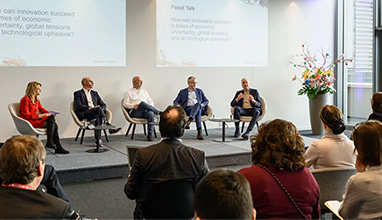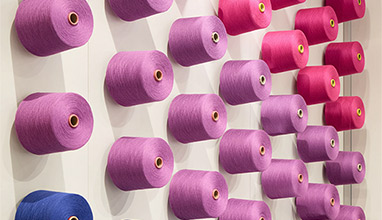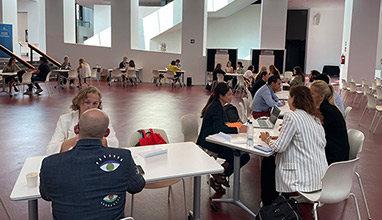High energy costs undermine crucial transformation of the textile and clothing industry
The current energy crisis is impacting on the competitiveness of the European textile and clothing industry. Because there are limited alternatives to the use of gas in different parts of the production process, production costs increase sharply. EURATEX asks the European Commission and Member States to urgently support the industry to avoid company closures. At the same time, we need a long term vision to move towards climate neutrality, while keeping the T&C industry internationally competitive.

EURATEX presented ten key requirements to Kadri Simson, European Commissioner for Energy, to develop such a vision:
1. The apparel and textile industry needs a safe supply with sufficient green energy (electricity and gas) at internationally competitive prices.
2. The transformation of industry requires access to very significant amounts of renewable energy at competitive costs. Additional investments in infrastructure will also be needed to guarantee access to new renewable energy supplies.
3. Until a global (or at least G 20 level) carbon price or other means for a global level playing field in climate protection are implemented, competitive prices for green energy must be granted at European or national levels (e.g. CCfDs, reduction on levies, targeted subsidies).
4. As the European textile and clothing sector faces global competition mainly form countries/regions with less stringent climate ambitions, it is of utmost importance that the European textile and clothing companies are prevented form direct and indirect carbon leakage.
5. EU-policy should support solutions, e.g. through targeted subsidies (for hydrogen, energy grids, R&D, technology roadmap studies etc.).
6. A dedicated approach for SMEs might be appropriate as SMEs do not have the skills/know-how to further improve their energy efficiency and/or becoming carbon neutral.
7. CAPEX and OPEX support will be necessary for breakthrough technologies, like hydrogen.
8. The Fit-for-55-Package must support the European Textile and Clothing industry in decarbonization and carbon neutrality. The EU must therefore advocate a global level playing field more than before. The primary goal must be to establish an internationally uniform, binding CO2 pricing, preferably in the form of a standard at G-7 / G-20 level.
9. EU-policy must not hinder solutions, e.g. we need reasonable state aid rules (compensating the gap between national energy or climate levies and a globally competitive energy price should not be seen as a subsidy).
10. The European Textile and Clothing industry has made use of economically viable potentials to continuously improve energy efficiency over many years and decades. The obligation to implement further measures must be taken considering investment cycles that are in line with practice. Attention must be paid to the proportionality of costs without weakening the competitive position in the EU internal market or with competitors outside the EU.
All this is based on the EURATEX position on EU climate and energy policy
Making the European textile and clothing industry climate friendly, while keeping it internationally competitive
The European textile and clothing industry (T&C industry) represents more than 160.000 companies, generating a turnover of around 160 billion Euros per year, employing 1.5 Mio. people. The industry covers a broad textile supply chain, from fibres to yarn to fabrics and finally to finished textiles and clothing. It produces products which are necessary, beautiful, protecting, energy saving, warming, live saving and much more. The textile industry recognizes that the protection of the climate is one of the most important challenges and tasks of mankind in our times. Over the past 20 years the European textile industry has reduced its fossil fuel based energy intensity by more than 60%.
Notwithstanding these efforts the textile industry is committed to continue and
if possible to intensify its efforts to further decarbonize. However, since the lowhanging
fruits have already been widely picked, the further transformation to a
low-carbon textile industry will largely depend on new breakthrough technologies
for the existing processes.
This transformation needs to be considered in a broader global environment in
which the European Textile industry operates and that is characterized by a fierce
competition. Therefore solutions have to be found which take into account the
international competitiveness of our industry and prevent carbon leakage.
Breakthrough technologies needed to further decarbonize
In several stages of its supply chain like fibre production, spinning, weaving, production of non-wovens or finishing, the textile industry is dependent on the use of fuels like natural gas and electricity, which inevitably lead to the emission of greenhouse gases (scope 1 and 2 greenhouse gas (GHG) emissions). This energy and electricity usage is essential for the production of textiles and apparel and can only be further lowered by improving energy efficiency following the investment cycles in machinery and aggregates. The industry is looking with interest to possible breakthrough technologies in energy savings which would be much welcome.
Companies would invest in those technologies, if the investment could be sustainably financed in view of the existing international competition. The textile sector as a whole might not be as energy-intensive as for example the steel or cement sector, but there are many activities such as yarn production (spinning, extrusion, …), finishing (dyeing, coating, …), or curing (cfr. stenter frames), that are energy-intensive.
To decarbonize these activities new technologies are needed and will require substantial investments, which are difficult to sustain in a very competitive environment mainly coming from countries/regions with less stringent climate ambitions.
High energy costs undermine crucial transformation
At the moment, the European textile and clothing companies are confronted with sky rising energy prices and CO2 prices (direct and indirect). Energy costs have tripled or even quadrupled over the last months. A cost increase which is impossible to pass on to customers due to the severe competition. In addition, there are a growing number of challenges that the European textile and clothing companies have to face simultaneously such as the transformation towards a circular economy, digitalization, decarbonization, traceability, due diligence, …
Being highly export driven, it is vital for the European textile industry to maintain competitiveness. Companies will only be able to take the required steps towards decarbonization and circularity/sustainability under favorable conditions.
It will therefore be one of the greatest challenges for the textile sector to finance the future costs of the sustainable and carbon neutral transition. The financial needs for the transition will cause a lack of investment as well as manpower capacity for innovations. For those greenhouse gas emissions which remain after using all options of improving energy efficiency, the industry has to find answers how these emissions can be brought down to zero or at least be compensated, e.g. by climate certificates. Currently technical solutions like Carbon Capture and Usage (CCU) are economically not viable or cannot be implemented in present installations. The European apparel and textile industry will also look at the greenhouse gas emissions which emerge from its long supply chain and other indirect emissions (scope 3 GHG emissions). These emissions should also be lowered through cooperation along the value chain or should at least be compensated.
Hits: 8890 | Leave a comment


















